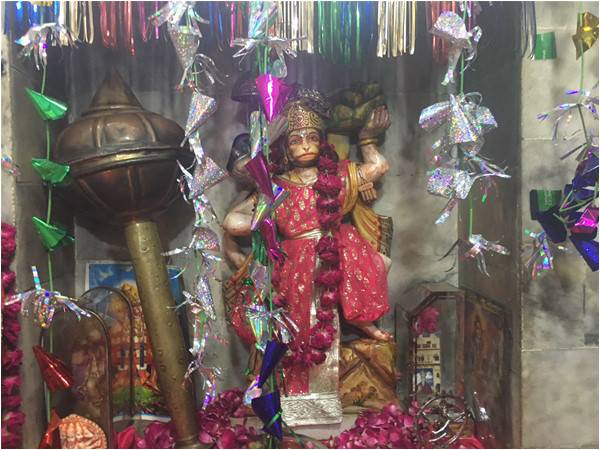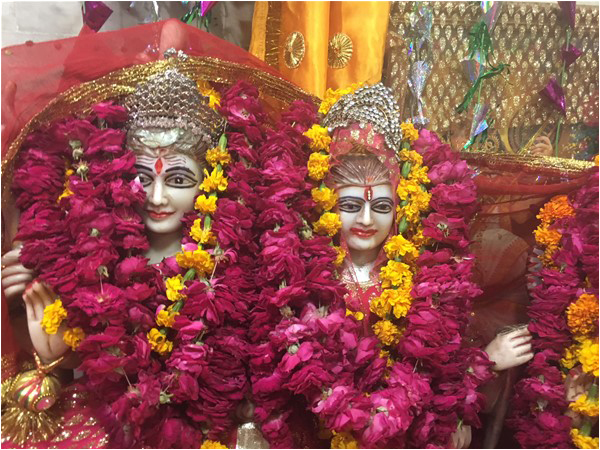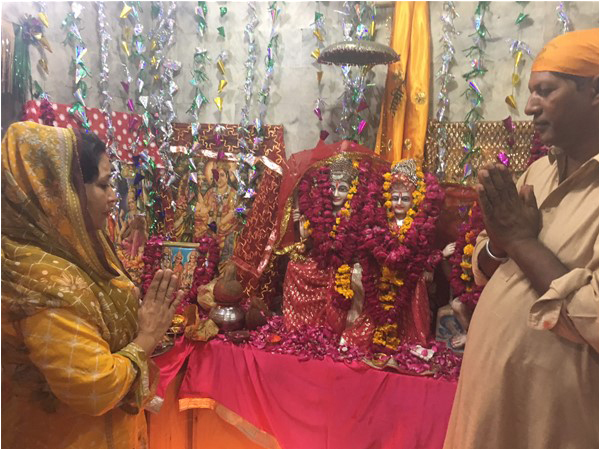
Lahore’s Diwali ceremony this year was a dismal affair – one that symbolises the struggle of Pakistan’s minorities.
Last week, I went to attend the sole Diwali ceremony held in Lahore. I imagined it to be a glorious affair complete with rangoli, phuljhari and sweetmeats.
I first approached the Valmiki Mandir, the oldest known temple in the city that is still functional, located in Lahore’s famed Anarkali bazaar. But the brother of the temple’s caretaker had died a few days before, and there were no celebrations taking place. The Valmiki temple didn’t look like a temple anymore. The original temple was demolished in 1992 as a reaction to the Babri mosque’s destruction. Only a small fraction of the old building – the only one I could notice in the night – was visible: one turret. A small room on the side had little statues of goddesses, and they too were draped with the Pakistani flags to prevent another desecration.

The temple’s caretaker directed me to the Krishna Temple on Lahore’s Ravi Road. I had heard of the temple but never seen it.
When I reached the spot, I could see the tents and lights, and hear the loudspeakers from a distance. The police and TV channel vans had blocked the street and were seeking identification documents.
The temple was on a street that shoots off to the left of the Ravi Road if you approach it from Data Sahib’s shrine.
The ceremony appeared to an observer like a poorly organised small-town wedding held on the road – which is illegal. The usual culprits were present at the entrance: the police with their vans and barricades, but also the channel vans with their dish antennas and vibrant channel logos. The police wouldn’t let me go inside for “security reasons.” A young police officer kept asserting that this ceremony is for “non-Muslims” only.
Eventually, a merciful policeman allowed me inside, and the stage full of people greeted me. The man on the microphone was praising the restoration of a temple in Chakwal.
The temple was as neglected, impoverished and suffocated as the religious minorities themselves are in Pakistan. People were sitting in the crowded single-room establishment as if it was a railway station. There was a certain light-heartedness here that was absent outside. Everyone was chatting, laughing and eating. On the left of the entrance was a smaller room housing the deities and on the right was a staircase that led to the rooftop. In front of me was a wall covered with banners saying “Happy Diwali from the Hindu Community” – a painful reminder that they are not a part of the “majority.”
The worship place was again on the side, and in a smaller room – something that I suspect might be another tactic to safeguard the statues from desecrators. People were coming to see the deities, saying their prayers there and leaving swiftly because a line of worshippers was waiting for their turn. There was the scent of rose and marigold flowers as there is on the weddings. Pieces of a creamy pink cake were being distributed as prasad – the devotional offering given to devotees as a sign of gratitude. Sadly I missed the chance to have them.
One young woman in a light green sari was giving out Chocolate Chip cookies for prasad. She was a marketing manager at a firm nearby. Interestingly, she didn’t offer me the prasad, and I didn’t ask. She probably thought I would refuse and I feared she might. I tried to get my hands on the orange gourmet mithai (sweets) box, but even that finished before I could push my way through the crowd. The devotees were mostly Christians – which isn’t surprising because many Hindus in Lahore and Punjab converted to Christianity to retain their properties and stay in their indigenous lands after Partition. I also met a few Sikhs.
Now and then, a TV reporter would come by with a fancy camera and bright flashlight. The reporter would ask them how they felt or what they liked about this day and everyone would state they were happy. Some people would say they want “peace.” The “inter-faith harmony” function outside kept blaring on the speakers there. Everyone was praising the efforts of someone else, so much so that one would feel Pakistan is a haven for non-Muslims.
I asked a few people if there would be any phuljhari or patakhe (fireworks). One man quipped that it is illegal and the police would arrest them if they lighted those things. He said it so light-heartedly that everyone started laughing. We were all acutely aware of the tension – everyone was pretending things were alright.
The only group of people that didn’t fake anything was the children. They were too young to understand cliches like “peace”, “inter-faith harmony” and “respect for Islam.”
met two girls, and they had Islamic names. Why would an indigenous community thousands of years suddenly start giving their daughters Arabic names like Sonia and Muqadas? I have never seen such “inter-faith” harmony elsewhere.

Most of the children seemed baffled, nervous and under-confident. Hardly any of them was dressed for the occasion. They weren’t cheerful like children usually are. They were visibly poverty-stricken, malnourished and often unaware of what Diwali signifies, despite it being the main festival of their community. Many of the nonchalant children didn’t want to talk to me. Those who did talk appeared to be confused.
Lahore wasn’t a Hindu-majority town before 1947, as is popularly believed in India today. But it did have a significant Sikh and Hindu community before the 1947 Partition. Roughly one third of pre-Partition Lahore was non-Muslim, and this was an affluent lot. When they escaped the riots in 1947, they are said to have left behind some notable properties and businesses.
But it was evident that night that even the last remnants of this multicultural heritage are struggling to survive in Lahore, which is mythologised as a city started by the son of Sita and Rama. Now, something as innocuous as the “festival of lights” has to be monitored, policed, restricted and then camouflaged as an event on “inter-faith harmony” and presented in the mass media as a token achievement.
On the stage, the group of activists and representatives of different religions gave speeches, prizes, and also lighted candle ceremony. Everyone in the crowd seemed eagerly waiting for such drama to end and the dinner to start.
When I was getting out of the sad Diwali ceremony where most rituals of Diwali were illegal – the minorities minister of Punjab was also leaving the premises. His job was also complete and the next day’s newspapers would, of course, carry a photograph of him as proof. Most Hindus would have been relieved that at least some lights and a stage were allowed. TV channels would show the animated faces of temple-goers in one of two functional mandirs in Lahore. And the next day newspapers would report, with some delight, that at least one Diwali ceremony did take place in Lahore. It is all meant to be very reassuring for those who believe that Pakistani minorities are not as miserable as the West believes.
The Ravi Road leads from the shrine of the Lahore’s Sufi saint, Data Ganj Baksh to the Minar-e-Pakistan. Data Ganj Baksh was known for his graciousness. Minar-e-Pakistan commemorates the Lahore Resolution – which is said to be the first formal statement by the All India Muslim League that aimed to establish a separate state for Indian Muslims. On the same road, in the middle of these two extraordinary structures, is a lonesome temple that possibly preceded them and is now waiting for some support.
Last week, I went to attend the sole Diwali ceremony held in Lahore. I imagined it to be a glorious affair complete with rangoli, phuljhari and sweetmeats.
I first approached the Valmiki Mandir, the oldest known temple in the city that is still functional, located in Lahore’s famed Anarkali bazaar. But the brother of the temple’s caretaker had died a few days before, and there were no celebrations taking place. The Valmiki temple didn’t look like a temple anymore. The original temple was demolished in 1992 as a reaction to the Babri mosque’s destruction. Only a small fraction of the old building – the only one I could notice in the night – was visible: one turret. A small room on the side had little statues of goddesses, and they too were draped with the Pakistani flags to prevent another desecration.

The temple’s caretaker directed me to the Krishna Temple on Lahore’s Ravi Road. I had heard of the temple but never seen it.
When I reached the spot, I could see the tents and lights, and hear the loudspeakers from a distance. The police and TV channel vans had blocked the street and were seeking identification documents.
The temple was on a street that shoots off to the left of the Ravi Road if you approach it from Data Sahib’s shrine.
The ceremony appeared to an observer like a poorly organised small-town wedding held on the road – which is illegal. The usual culprits were present at the entrance: the police with their vans and barricades, but also the channel vans with their dish antennas and vibrant channel logos. The police wouldn’t let me go inside for “security reasons.” A young police officer kept asserting that this ceremony is for “non-Muslims” only.
Eventually, a merciful policeman allowed me inside, and the stage full of people greeted me. The man on the microphone was praising the restoration of a temple in Chakwal.
The temple was as neglected, impoverished and suffocated as the religious minorities themselves are in Pakistan. People were sitting in the crowded single-room establishment as if it was a railway station. There was a certain light-heartedness here that was absent outside. Everyone was chatting, laughing and eating. On the left of the entrance was a smaller room housing the deities and on the right was a staircase that led to the rooftop. In front of me was a wall covered with banners saying “Happy Diwali from the Hindu Community” – a painful reminder that they are not a part of the “majority.”
The worship place was again on the side, and in a smaller room – something that I suspect might be another tactic to safeguard the statues from desecrators. People were coming to see the deities, saying their prayers there and leaving swiftly because a line of worshippers was waiting for their turn. There was the scent of rose and marigold flowers as there is on the weddings. Pieces of a creamy pink cake were being distributed as prasad – the devotional offering given to devotees as a sign of gratitude. Sadly I missed the chance to have them.
A young police officer kept asserting that this ceremony is for "non-Muslims" only
One young woman in a light green sari was giving out Chocolate Chip cookies for prasad. She was a marketing manager at a firm nearby. Interestingly, she didn’t offer me the prasad, and I didn’t ask. She probably thought I would refuse and I feared she might. I tried to get my hands on the orange gourmet mithai (sweets) box, but even that finished before I could push my way through the crowd. The devotees were mostly Christians – which isn’t surprising because many Hindus in Lahore and Punjab converted to Christianity to retain their properties and stay in their indigenous lands after Partition. I also met a few Sikhs.
Now and then, a TV reporter would come by with a fancy camera and bright flashlight. The reporter would ask them how they felt or what they liked about this day and everyone would state they were happy. Some people would say they want “peace.” The “inter-faith harmony” function outside kept blaring on the speakers there. Everyone was praising the efforts of someone else, so much so that one would feel Pakistan is a haven for non-Muslims.
I asked a few people if there would be any phuljhari or patakhe (fireworks). One man quipped that it is illegal and the police would arrest them if they lighted those things. He said it so light-heartedly that everyone started laughing. We were all acutely aware of the tension – everyone was pretending things were alright.
The only group of people that didn’t fake anything was the children. They were too young to understand cliches like “peace”, “inter-faith harmony” and “respect for Islam.”
met two girls, and they had Islamic names. Why would an indigenous community thousands of years suddenly start giving their daughters Arabic names like Sonia and Muqadas? I have never seen such “inter-faith” harmony elsewhere.

Most of the children seemed baffled, nervous and under-confident. Hardly any of them was dressed for the occasion. They weren’t cheerful like children usually are. They were visibly poverty-stricken, malnourished and often unaware of what Diwali signifies, despite it being the main festival of their community. Many of the nonchalant children didn’t want to talk to me. Those who did talk appeared to be confused.
Lahore wasn’t a Hindu-majority town before 1947, as is popularly believed in India today. But it did have a significant Sikh and Hindu community before the 1947 Partition. Roughly one third of pre-Partition Lahore was non-Muslim, and this was an affluent lot. When they escaped the riots in 1947, they are said to have left behind some notable properties and businesses.
But it was evident that night that even the last remnants of this multicultural heritage are struggling to survive in Lahore, which is mythologised as a city started by the son of Sita and Rama. Now, something as innocuous as the “festival of lights” has to be monitored, policed, restricted and then camouflaged as an event on “inter-faith harmony” and presented in the mass media as a token achievement.
On the stage, the group of activists and representatives of different religions gave speeches, prizes, and also lighted candle ceremony. Everyone in the crowd seemed eagerly waiting for such drama to end and the dinner to start.
When I was getting out of the sad Diwali ceremony where most rituals of Diwali were illegal – the minorities minister of Punjab was also leaving the premises. His job was also complete and the next day’s newspapers would, of course, carry a photograph of him as proof. Most Hindus would have been relieved that at least some lights and a stage were allowed. TV channels would show the animated faces of temple-goers in one of two functional mandirs in Lahore. And the next day newspapers would report, with some delight, that at least one Diwali ceremony did take place in Lahore. It is all meant to be very reassuring for those who believe that Pakistani minorities are not as miserable as the West believes.
The Ravi Road leads from the shrine of the Lahore’s Sufi saint, Data Ganj Baksh to the Minar-e-Pakistan. Data Ganj Baksh was known for his graciousness. Minar-e-Pakistan commemorates the Lahore Resolution – which is said to be the first formal statement by the All India Muslim League that aimed to establish a separate state for Indian Muslims. On the same road, in the middle of these two extraordinary structures, is a lonesome temple that possibly preceded them and is now waiting for some support.

